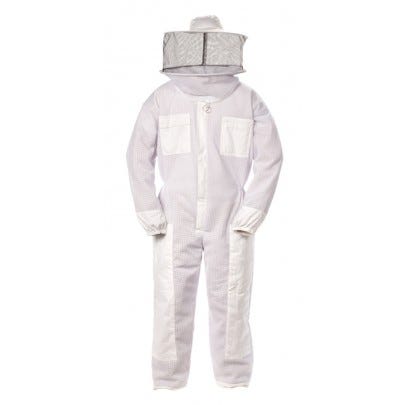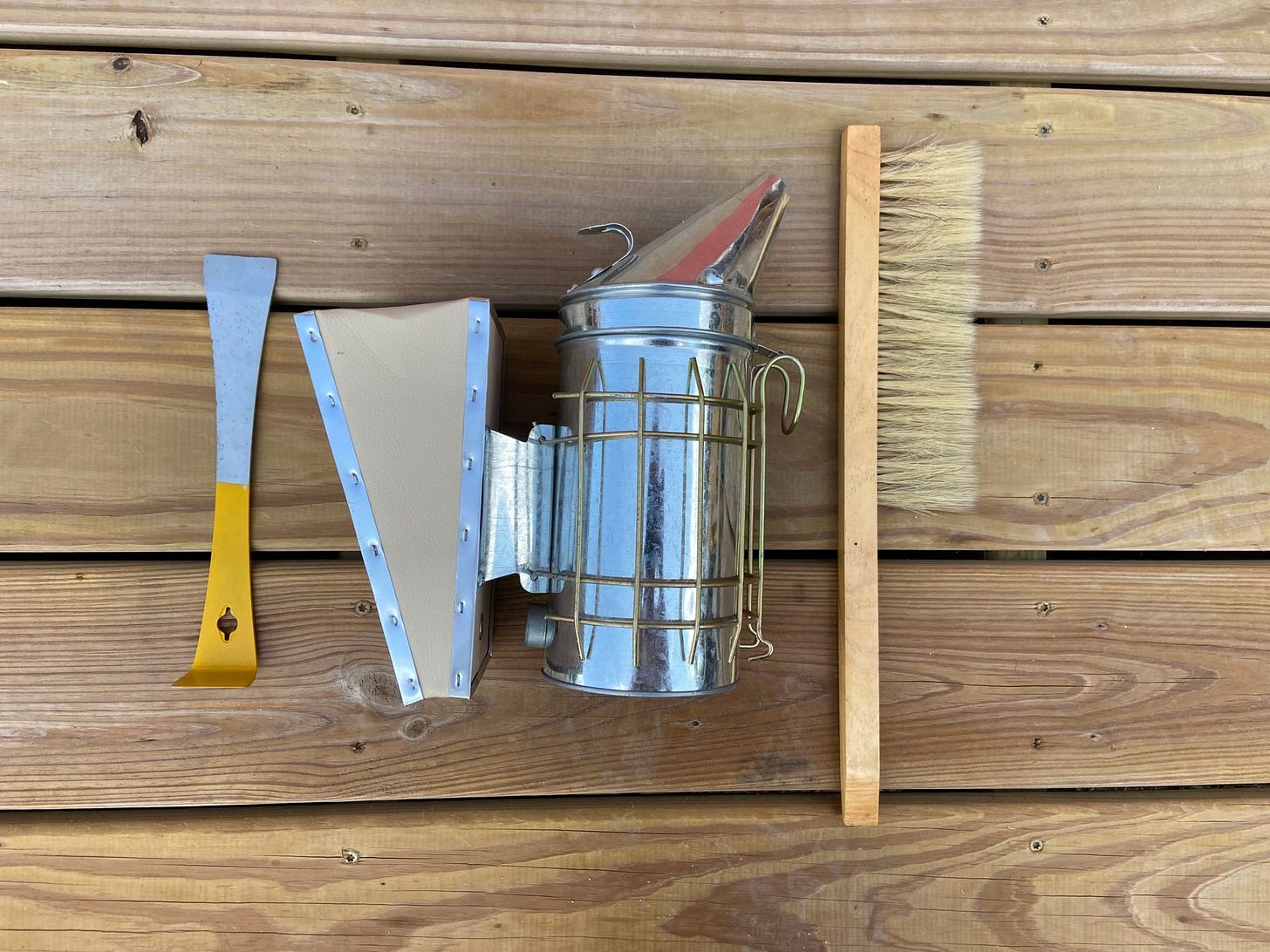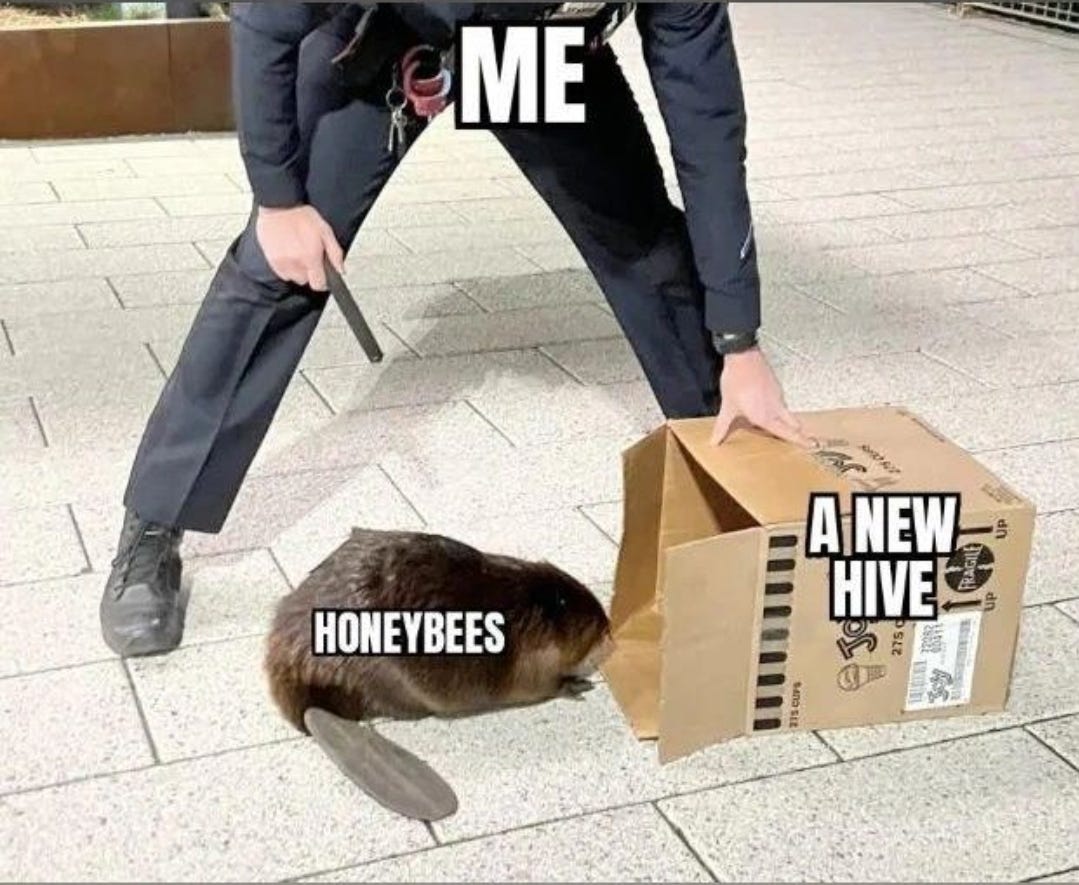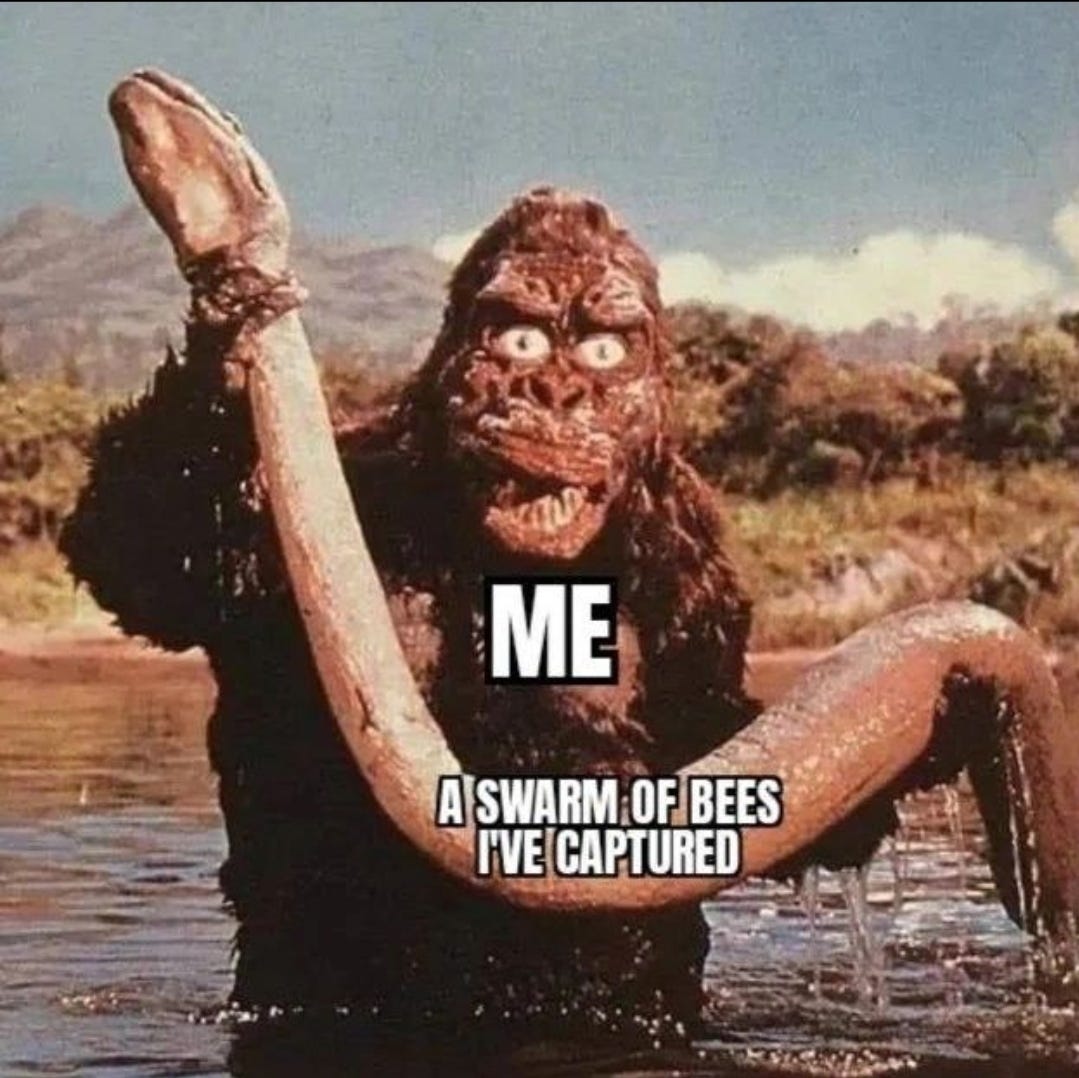Navigating the Beehive: Understanding Roles, Life Cycles, and Hive Types
What makes a beehive hum
In beekeeping, you have three types of bees: queens, drones, and worker bees. While queens get a majority of the attention, the majority of bees, over 90% of the ones in your hive, are worker bees. The life of a worker bee is anything but simple— and unlike what you might think, they are not specialists in any one thing— although in a sense they do learn to be, as we’ll discuss. If you’ve stumbled across this piece and are looking for a greater context, this is part of a multi-part series on beekeeping and reviewing how science understands beekeeping, and what it would look like to follow a science-based, historically-influenced framework for beekeeping.
Let’s talk about those worker bees. They start working as nurse bees, graduate to house bees, and spend the rest of their lives as foragers. It’s the nurse bee's job to feed other worker bees when they first emerge from their cells as adults. Nurse bees usually begin working to clean cells by removing the cocoons and excreta of recently hatched bees. On about the third day, worker bees will begin nursing or feeding brood. They will do this for a week or two, depending on the conditions.
Basically, they learn how to be nurse bees by existing. These baby nurse bees feed "royal jelly" to newly hatched larvae. Royal jelly is secreted from glands in their heads. By the time they’re 10 days old, the brood food glands will start to dry up on the worker bees and eight wax glands on the underside of the worker's abdomen will start to secrete wax, pushing the worker into the house bee stage. She can then begin to work on building comb and repairing damaged wax. It’s around this age when they also begin to take orientation flights around the hive to learn its location and exterior conditions. They continue taking these flights occasionally until they move into the foraging stage.
While still in the hive during this time, but capable of some basic flying, these workers receive pollen and nectar from foragers and deposit it in comb cells. They "stretch" the nectar they receive with their mouthparts to reduce the moisture content until the nectar is ripe honey; then they cap the cell. In addition, these house bees “process” pollen into beebread by adding small amounts of nectar and enzymes to the pollen dropped in cells by foragers.
When daily foraging flights begin on about the twenty-first day, the wax glands of the worker bee begin to atrophy and the worker moves squarely into the forager role. From this point forward, the worker spends their days flying out into the world to locate, gather, and bring back all the things honey bee colonies need to prosper: water, pollen, nectar, and resins to make propolis. They will continue to forage until their bodies give out at about six weeks old. That’s the general lifecycle for the bees in your hive.
And, speaking of hives, there are a lot of variations on hives. I personally use a mix of Langstroth & modified topbar hives; Langstroths are the ones folks usually think of when they think of beekeeping— they’re square, stacked boxes about 3 feet tall at their largest. Langstroths are by far the most common. The other less common hive, but definitely #2 is a topbar hive, which have some overlaps with Langstroth hives, and we’re gonna cover each of those separately– their pros and cons, and a bit about where they actually came from in a few episodes.
Topbars are more common in the South as they tend to dissipate heat a little bit better that way. The other theoretical benefit to this is that the hives are more representative of how they would be found in the wild, and the frames can be easier to access because of the height. Skep hives are the third most common, and they compose less than 1% of all hives and I don’t believe they’re used on any commercial size. Skeps are usually made from a straw and are domed baskets. These are some of the earliest forms of hives in recorded history and traditionally were designed to be destroyed, killing the hive in order to collect the honey and comb, although this is starting to be somewhat challenged in academic spaces, and we’ll talk about this in further detail in another article.
From the technical perspective, another thing to consider is protective clothing: typically that means a veil, bee suit, and gloves. The veil is considered the most important piece of clothing a beekeeper can wear. That’s the thing that makes you look like the Michelin man. Stings on the hands and body can be tolerated (by most people), but stings to the face are particularly not enjoyable.
Now, the bee suits are white coveralls made of sturdy fabric to protect the beekeeper's whole body from stings. Like I said, they are heavy and you’ll get sweaty. Don’t buy cheap brands, you won’t trust the fabric to protect you, especially if you’re nervous about it for the first time. All of the suits have elastic cuffs on the arms and legs to seal out bees, but you can also tuck them into socks and they’ll be tucked into your gloves too. Bee suits come in many styles, some with integrated veils. Beekeeping gloves are designed to reduce stings to the hands and lower arms. Regular work gloves can trap bees in the wrist area and lead to stings, while beekeeping gloves have elastics at the elbow to reduce that risk.
Now we’ve talked a lot about the bees themselves, and about your suit, and there’s some other stuff you’ll need. For tools, you'll probably want to have these three tools for working with your bees: A hive tool, a smoker, and a bee brush. The hive tool is used for lots of prying, scraping, and leveraging tasks around and in a bee hive. It’s basically like a 5-in-1, but with a little bit of a different shape.
So for our hive tool, the scraping end is sharpened like a chisel to fit between frames in the hive and dislodge any that are stuck together with wax and propolis. You’ll need it, but you could probably make do with a flathead screwdriver if you needed to. They’re like $10, so definitely worth the investment. It can also be used to scrape off burr comb from the top and bottom of a frame and to destroy swarm cells if needed. The prying end of the tool is good for lifting off covers and prying frames up high enough to get a hold of them with your fingers, which can be particularly difficult with gloves on.
Now let’s talk about the smoker. So, I’ll be honest, the longer I keep bees, and especially if they’re Italian honey bees, which I’m trying to get away from, but for now I don’t really use a smoker, but definitely for a new beekeeper it’s incredibly helpful. It is used to subdue the bees when opening a hive. When bees sense smoke, they attempt to engorge themselves on honey to prepare for an emergency flight, and the scent of smoke masks the bees' alarm pheromones.
Basically, the bees go into emergency mode and you’re not the emergency. Now, you don’t need to use one to open a hive, and honestly, I almost never use mine if I absolutely don’t have to. By trying to limit accessing the hive to evening and early morning, you can often get away with not using a smoker. One of the negatives of using it is that because the bees stuff themselves with honey, they usually lose up to a week’s worth of work in honey production. In shorter summer seasons like where I live, I don’t want to give up an extra week of production if I don’t absolutely have to.
Lastly, and I guess most importantly, you have to decide where to get your bees, which can be bought as packages. You can get them through your local beekeepers association or you can order them online and pick them up at the post office.
Italian bees are the most popular strain in the United States. They are light yellowish or brown with alternating stripes of brown and black on the abdomen. The lighter color of the Italian queen makes her easy to find in the hive.
They’re from Italy, and we’ll talk about the different strains in further depth in a later episode. But for now, It’s important to just know there are basically 3 major strains; Italians, Caucasians, and Carniolans. And while the honeybees that come from the US at this point have blended these strains to an extent, usually it’s pretty clear which genetics are at play in your hive after some experience.
Many of these strains have been even further selected for specific characteristics such as productivity, gentleness, or mite and disease resistance. In order to acquire a particular strain of bee, you only need to purchase a queen, since the queen controls the genetics of the colony. And, again, it’s a LOT more complex than that, and we’re going to be doing separate articles both on bee genetics and queens, but for now, that’s all we’re gonna go into it.
Italian bees start brood rearing early in the spring and continue through late fall, which results in a large population and a considerable amount of nectar in a short period of time. Now despite these great traits, there are some downsides to them. They often require more maintenance because of the fact they require more honey stores than other strains. They also exhibit weaker orientation, that is, finding their way back home, resulting in more frequent drifting from one colony to another. Not only does this mean they don’t come home sometimes, but also because of this, they are good at transferring disease and mites. They also exhibit a strong inclination to robbing, which can also aid in the spread of disease.
Now, Caucasian bees are the gentlest of all honey bees. They are dark to black in color with gray bands on the abdomen. They tend to construct burr comb and use large amounts of propolis to fasten combs and reduce the size of the entrance. Because they propolize excessively, they are not considered suitable for producing honey to be sold while still in the comb. Caucasians are inclined to drifting and robbing, but not to excessive swarming.
Caucasians normally do not reach full strength before midsummer, and they conserve their honey stores better than the Italians do. They also forage at somewhat lower temperatures and under less favorable climatic conditions than do Italian bees and are reported to show some resistance to European foulbrood. Caucasians are available but not common.
The last of the 3 major strains of bees are Carniolan, also known as Carnies, which can be identified by their dark coloring with brown bands on the abdomen. These ladies overwinter as small clusters but increase rapidly in the spring after the first pollen. They increase so rapidly that their major disadvantage to Carnies is excessive swarming, which is basically when the hive feels too crowded and half of the hive leaves. Due to their small overwintering cluster size, they are very economical in their food consumption, even under unfavorable climatic conditions, and they overwinter well. They are generally pretty good bees by most metrics, but despite this, while they are available, they are not common. Some of the stock is listed as New World Carnies, considered by some beekeepers to be the better Carnie strain because they’re less likely to swarm, basically. Now, even though these are the 3 most common strains, there are a few others, and even of these 3, Italians make up the bulk of most beekeeping.
There are a few other more rare strains that are worth at least mentioning. If you’re in a cooler climate, Buckfast bees are worth considering; they’re from southwestern England and are readily available in the United States. They are more resistant to tracheal mites than other bee strains and also better suited to cool climates. I’d imagine they’re best suited for the northwestern US. Another one that you’ll hear a lot about is Russian bees. Russian bees have been exposed to Varroa mites in their native homeland over a long period of time and have developed a natural resistance to them. The USDA carefully selected and imported Russian queens into the United States. Russian colonies were created and evaluated in isolation before being released to commercial breeders to be propagated. Russian queens are now available to be purchased from Russian queen breeders.
This brings up an important question of what exactly a package of bees really is. It is not, despite what you’d expect, a small hive. Beekeepers simply take frames of adult workers out of their hives and shake them off the frames, through a funnel, and into the shipping package. So they may or may not be related to one another, may or may not be diverse in the ages of the bees— it’s completely random.
Most packages are 3 lbs, and that means many times bees from multiple hives. A young mated queen unfamiliar to the worker bees is placed separately in a small queen cage, and that cage is placed inside the package with the workers so that they can become comfortable with her on their journey. The queen cage is attached to the shipping crate at the top, near the feeder. Two or three worker bees are commonly caged with the queen to care for her. Queen cages are supplied with an additional food source of sugar candy. Over the course of a week or so, the worker bees basically learn the smell of the queen until they recognize her as THEIR queen.
Now, if you don’t wanna do the bee package thing, another option is called a Nuc, which is short for a nucleus colony which is probably closer to what people would expect for starting a new hive— it has 3 or so frames of workers and brood, some honey, pollen, and a queen. It’s basically the very early stages of a hive but is typically more expensive.
Now your last option requires a little more comfort on the part of the beekeeper, and that’s capturing a swarm, which is a hanging cluster of bees. There can be as many as 25,000 bees in a swarm. If you have the opportunity to capture a swarm, it can be a cheap way to get a lot of bees to populate your hive or replace winter losses.
When a swarm leaves the nest, it does not fly far at first. You’ll see this thing that looks like a foot-long oval of buzzing suddenly hanging from a tree— this is a temporary stop while they look for a new home. From there, 20-50 scout bees locate a new cavity, which may take a few hours or several days. Hollow trees are the most common new nesting site, though they may settle in the cavity of a wall or under a porch. The swarm may fly up to a mile to its final nesting site. Swarming creates a vulnerable time in the life of honey bees. A swarm will starve if it does not move quickly, or the queen may get lost or captured by predators during flight.
And this rounds out most of the basics on beekeeping from a functional aspect. You’ll notice we didn’t talk about disease or disease treatments— and that was purposefully. We’ll be exploring disease in further detail in later episodes, and of course, if you stumbled across this as your first exposure to our bee content, swing back to part 1 when you’ve got a moment. In the next installment of the bee series, we’ll be talking about honeybee genetics, and explore the how and why and ‘what’s the big deal?’ about these different types of honeybees.
If you’ve enjoyed this piece, which is equal to a 10-page chapter, of (so far) a 736 page book with 368 sources, you can support our work in a number of ways. The first is by sharing this article with folks you think would find it interesting. Second, you can listen to the audio version of this episode, #140, of the Poor Proles Almanac wherever you get your podcasts. If you’d like to financially support the project, and get exclusive access to our limited paywalled content, you can become a paid subscriber on Substack or Patreon, which will both give you access to the paywalled content and in the case of Patreon, early access to the audio episodes as well.









